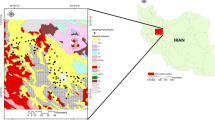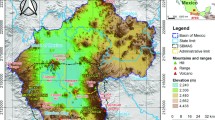Abstract
The primary objective of this study was to provide a detailed framework to use the spatio-temporal kriging to model the spatio-temporal variations of salinity data and predict saltwater intrusion into freshwater aquifers in the vicinity of deserts. EC data, measured in extraction wells in the Mahvelat plain located in the Northeastern part of Iran, available from 2007 to 2013, were used to demonstrate the developed framework. The source of data was not a well-designed measurement network. Therefore, to homogenize the data, spatial analysis was used to find EC distribution in the area in each year of study. To conduct the spatial analysis, a guideline and a systematic process were developed to select an appropriate kriging method and optimize its parameters. This process can be applied to different variables. After spatial analysis of EC data for all the years of the analysis period using empirical Bayesian kriging (EBK) method with manually optimized parameters, spatio-temporal and corresponding variogram analysis was conducted using R software. This process was based on a separable product-sum model applied to the data from 2007 to 2012. The data of 2013 and the data available for the years 1999 and 2006 were used for evaluating the performance of the spatio-temporal model. The EC distribution maps, developed for different years until 2021, show a high level of EC in the north, south, and west of the study area and growing saltwater intrusion into the central freshwater aquifer. This result can be attributed to the over-exploitation of the aquifer and hydraulic head and gradient distribution in the area. The framework provided in this study for spatio-temporal analysis of unstructured EC data is useful for groundwater managers in making proper decisions.











Similar content being viewed by others
References
Ahmed, S. (2002). Groundwater monitoring network design: application of geostatistics with a few case studies from a granitic aquifer in a semiarid region. In M. Singh, M. Al-Rashed, & M. M. Sherif (Eds.), Groundwater hydrology (pp. 37–57). Tokyo: Balkema.
Akbarzadeh, M., & Ghahraman, B. (2013). A combined strategy of entropy and spatio-temporal kriging in determining optimal network for groundwater quality monitoring of Mashhad basin (in Persian). Journal of Water and Soil, 27, 613–629.
Akita, Y., Carter, G., & Serre, M. L. (2007). Spatiotemporal nonattainment assessment of surface water tetrachloroethylene in New Jersey. Journal of Environmental Quality, 36, 508–520.
Alsaaran, N. (2000). Optimal interpolation and isarithmic mapping of groundwater salinity in Tebrak area, central Saudi Arabia. Journal of King Saud University, 12, 49–58.
Barca, E., & Passarella, G. (2008). Spatial evaluation of the risk of groundwater quality degradation. A comparison between disjunctive kriging and geostatistical simulation. Environmental Monitoring and Assessment, 137, 261–273.
Bilgili, A. V. (2013). Spatial assessment of soil salinity in the Harran Plain using multiple kriging techniques. Environmental Monitoring and Assessment, 185(1), 777–795.
Bilonick, R. A. (1985). The space-time distribution of sulfate deposition in the northeastern United States. Atmospheric Environment, 19, 1829–1845.
Bogaert, P., & Christakos, G. (1997). Stochastic analysis of spatiotemporal solute content measurement using a regression model. Stochastic Hydrology and Hydraulics, 11, 267–295.
Brus, D. J., & Heuvelink, G. B. M. (2007). Optimization of sample patterns for universal kriging of environmental variables. Geoderma, 138, 86–95.
Cressie, N. (1993). Statistics for spatial data. New York: Wiley.
Cressie, N., & Huang, H. (1999). Classes of nonseparable, spatiotemporal stationary covariance functions. Journal of the American Statistical Association, 94, 1330–1340.
D'Agostino, V., Greene, E. A., Passarella, G., & Vurro, M. (1998). Spatial and temporal study of nitrate concentration in groundwater by means of coregionalization. Environmental Geology, 36, 285–295.
De Cesare, L., Myers, D. E., & Posa, D. (2001). Estimating and modeling space-time correlation structures. Statistics & Probability Letters, 51, 9–14.
De Iaco, S., Myers, D. E., & Posa, D. (2001). Space-time analysis using a general product-sum model. Statistics & Probability Letters, 52, 21–28.
Eynon, B. P., & Switzer, P. (1983). The variability of rainfall acidity. Canadian Journal of Statistics, 11, 11–22.
FAO. (1989). Arid zone forestry, a guide for field technicians. Rome: Food and Agriculture Organization.
Fuentes, M., Chen, L., & Davis, J. M. (2008). A class of nonseparable and nonstationary spatial temporal covariance functions. Environmetrics, 19, 487–507.
Gaus, I., Kinniburgh, D. G., Talbot, J. C., & Webster, R. (2003). Geostatistical analysis of arsenic concentration in groundwater in Bangladesh using disjunctive kriging. Environmental Geology, 44, 939–948.
Gneiting, T., Genton, M. G., & Guttorp, P. (2007). Geostatistical space-time models, stationarity, separability and full symmetry. In B. Finkenstaedt, L. Held, & V. Isham (Eds.), Statistics of spatio-temporal systems: monographs in statistics and applied probability (pp. 151–175). Boca Raton: Chapman & Hall/CRC Press.
Haining, R. (1991). Spatial data analysis in the social and environmental sciences. Cambridge: Cambridge University Press.
Hu, K., Huang, Y., Li, H., Li, B., Chen, D., & White, R. E. (2005). Spatial variability of shallow groundwater level, electrical conductivity and nitrate concentration and risk assessment of nitrate contamination in North China Plain. Environment International, 31, 893–903.
Istok, J. D., & Cooper, R. M. (1988). Geostatistics applied to groundwater pollution. III: global estimates. Journal of Environmental Engineering, 114, 915–928.
Kent, J. T., Mohammadzadeh, M., & Mosammam, M. A. (2011). The dimple in Gneiting’s spatial-temporal covariance model. Biometrika, 98, 489–494.
Khattak, A., Ahmed, N., Hussein, I., Qazi, A., Alikhan, S., Rehman, A., & Iqbal, N. (2014). Spatial distribution of salinity in shallow groundwater used for crop irrigation. Pakistan Journal of Botany, 46, 531–537.
Krivoruchko, K. (2011). Spatial statistical data analysis for GIS users. Redlands: Esri Press.
Li, B., Genton, M. G., & Sherman, M. (2007). A nonparametric assessment of properties of space-time covariance functions. Journal of the American Statistical Association, 102, 736–744.
Lu, N., & Zimmermann, D. L. (2005). The likelihood ratio test for a separable covariance matrix. Statistics & Probability Letters, 73, 449–457.
Mohammadzadeh, M. (2012). Spatial analysis and its applications (in Persian). Tehran: Tarbiat Modares University Press.
Moriasi, D. N., Arnold, J. G., Van Liew, M. W., Bingner, R. L., Harmel, R. D., & Veith, T. L. (2007). Model evaluation guidelines for systematic quantification of accuracy in watershed simulations. Transactions of the ASABE, 50, 885–900.
Navarro-Pedreño, J., Jordan, M. M., Melendez-Pastor, I., Gomez, I., Juan, P., & Mateu, J. (2007). Estimation of soil salinity in semi-arid land using a geostatistical model. Land Degradation and Development, 18, 339–353.
Rodriguez-Iturbe, I., & Mejia, J. M. (1974). The design of rainfall networks in time and space. Water Resources Research, 10, 713–728.
Rouhani, S., & Hall, T. J. (1989). Space-time kriging of groundwater data. In M. Armstrong (Ed.), Geostatistics (pp. 639–651). USA: Kluwer Academic Publishers.
Rouhani, S., & Myers, D. E. (1990). Problems in space-time kriging of hydrogeological data. Math. Geology, 22, 611–623.
Sharafi, M., & Mohammadzadeh, M. (2009). Spatiotemporal kriging with external drift (in Persian). Journal of Statistical Research of Iran, 4, 15–28.
Stein, M. L. (2005). Space-time covariance functions. Journal of the American Statistical Association, 100, 310–321.
Sun, Y., Kang, S., Li, F., & Zhang, L. (2009). Comparison of interpolation methods for depth to groundwater and its temporal and spatial variations in the Minqin oasis of northwest China. Environmental Modeling & Software, 24, 1163–1170.
Wu, W., Yin, S., Liu, H., Niu, Y., & Bao, Z. (2014). The geostatistic-based spatial distribution variations of soil salts under long-term wastewater irrigation. Environmental Monitoring and Assessment, 186(10), 6747–6756.
Acknowledgements
The authors gratefully acknowledge the Khorasan Razavi Regional Water Authority for supporting this research.
Author information
Authors and Affiliations
Corresponding author
Rights and permissions
About this article
Cite this article
Bahrami Jovein, E., Hosseini, S.M. Predicting saltwater intrusion into aquifers in vicinity of deserts using spatio-temporal kriging. Environ Monit Assess 189, 81 (2017). https://doi.org/10.1007/s10661-017-5795-8
Received:
Accepted:
Published:
DOI: https://doi.org/10.1007/s10661-017-5795-8




